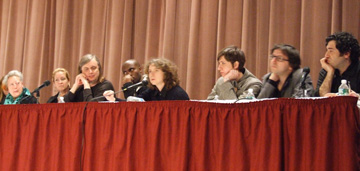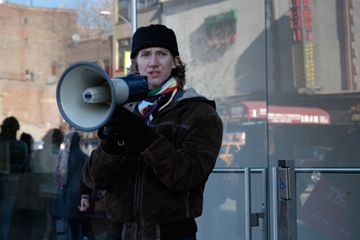Daniel Fuller, Senior Program Specialist at the Philadelphia Exhibitions Initiative, recently helped organize the Curating and Activism symposium at Moore College of Art & Design. The following is a recap of a day of public conversations, on issues of responsibility, and a short interview with the artist Sharon Hayes.

From L: Martha Wilson, Lorie Mertes, Steve Kurtz, Adam Pendleton, Sharon Hayes, Stamatina Gregory, Srdjan Jovanovic Weiss, and Michael Rakowitz. Photo by Gabrielle Lavin.
This past fall, when Janet Kaplan and Lorie Mertes first approached us at the Philadelphia Exhibitions Initiative about co-organizing a symposium on curating and activism, it was an exciting time. Ours: Democracy in the Age of Branding was at Parsons, Creative Time’s Democracy In America: The National Campaign was coming to a conclusion at the Convergence Center at the Park Avenue Armory, and Elizabeth Peyton was hustling to add her portrait of Michelle Obama to the New Museum retrospective. Everyone was gearing up for a historic election and there seemed to be a massive groundswell of grassroots organizing, both in the art world and everywhere else. The times have certainly changed since we first started planning the symposium, and that Saturday’s symposium was about how to maintain the level of fervor that propelled so many to the streets in the lead-up to November.
We conceived of a series of grouped conversations that would examine multiple ways in which curatorial activities can be directed toward social and political activism. The three panels included:
Curating and Self-Organization—Facilitating Interactions
featuring Katherine Carl/Srdjan Jovanovic Weiss + Michael Rakowitz + Carin Kuoni
The Project of Performance—The Body and the Public
featuring Sharon Hayes + Adam Pendleton + Martha Wilson
Models of Participation and Modes of Activism
featuring Stamatina Gregory + Steve Kurtz + Anton Vidokle
By bringing architects, artists, curators, and academics to the table, we hoped to provoke various opinions and strategies on how to effectively navigate the power dynamics involved in curating for social change. The general themes which seemed to be revisited with each panel were thoughts on participation and accidental activism. We repeatedly listened to a number of approaches to finding loopholes in the language of the law.
In regards to the battle for empowering “calls to action,” Martha Wilson got the crowd’s attention early when she declared that, “all art should be activist art and that all other is crap,” but Anton Vidokle made a plea for artists to be “radical,” not just use the “wishy-washy” term “activist,” saying that he sometimes goes to demonstrations “not as an artist, but as a person.”
In the aftermath of the symposium, I was able to reconnect via email with one of my favorite artists for a little follow-up question-and-answer. Coming of age in performance through identity politics in the downtown dance scene, New York-based Sharon Hayes works in performance, installation, and the production and perception of linguistics. Her staged speeches create opportunities to re-present the theater of politics in yesterday into contemporary public spaces. Her recent project for Creative Time, Revolutionary Love 1 & 2: I Am Your Worst Fear brought together 100 performers from the gay, lesbian, and transgendered communities of Denver and St. Paul to simultaneously read a love letter outside of the Democratic and Republican National Conventions. The script employed confessional texts from the Gay Liberation movement of the 1970s to confront audiences through a critical examination of love and war.

Sharon Hayes, Martha Wilson, and Lorie Mertes, Rochelle F. Levy Director & Chief Curator of The Galleries at Moore. Photo by Gabrielle Lavin
Daniel Fuller: This will be a bit out of context, but I’d like to quote you from Who Cares: “War changes everything and nothing.” Six years after the invasion of Iraq, it seems as though Obama’s exit strategy includes leaving through Afghanistan. As this or these wars drag on, so many become numb to the situation–as something going on “over there.” How does the probability of these wars being further extended impact or influence your work? Do you also find this numbing or is it strangely inspiring or reinvigorating to your artistic work?
Sharon Hayes: To me, a citizen of the U.S. whose government and military have been occupying, bombing, and leveling sanctions on Iraq and Afghanistan to greater and lesser degrees for my entire adult life, the continuation of these policies and activities are never inspiring or reinvigorating. On the other hand, I also wouldn’t say that the Obama administration’s plan for Afghanistan causes me numbness. Rather, I must admit I am perplexed and anxious, perplexed as to why Obama decided to escalate the fighting there and anxious about the impact it will have on the people in the region, the project and efforts to close Guantanamo, etc. In terms of my work, I have felt the need since the inauguration of Barack Obama in January, to work collectively with friends and colleagues to read, write, talk and think about the change (because I think it is a change) that Obama brings and brings to our work as artists.
DF: It’s been said that activism too often begins behind a computer, but if it stays there, it’s dead. Is participation, real live participation—a gathering in a town square—already a form of activism?
SH: I remember you asking this to the last panel and what popped into my head immediately then and still sticks now is NO! Participation, in and of itself, is not activism. People participate in activities, conversations on the internet, baseball games, college basketball tournaments, paint ball games, etc…and these things are not activism just because of their participation in them. It seems by “a gathering in a town square” you are already placing the frame of some political engagement onto your hypothetical scenario, but even still, going to a town square meeting that John McCain organizes during his presidential campaign is also not activism—political participation, sure. And perhaps many people who attend consider themselves activists in other facets of their life, but their attendance pure and simple does not, in my mind, constitute activism.
What your question begs is a clarified definition of activism, which is one of the questions and needs that came up on Saturday. Someone else can offer an abstract definition of activism. I can say the kind of activism that I am interested in is collectively engaged, potentially disparate, fragmented, and even pathetic activities whose aim is to increase the ability of poor, disempowered, disenfranchised, marginal groups and individuals to live lives that are safe and fulfilling to them and to resist the powers that decrease and impede on such safety and fulfillment. That includes increasing the access we all have to the resources we need to maintain a shared healthy, safe, and fulfilling set of lives over time.

Sharon Hayes, "I March in Tthe Parade of Liberty But As Long As I Love You I’m Not Free," 2007-8. Courtesy of Tanya Leighton Gallery, Berlin.
DF: You mentioned that “holding up a protest sign serves as a speech.” In regards to your “respeaking,” might there be a particular speech or quotation from the past that you are especially eager to “mine” and bring back into a public forum? Is there a certain cultural authenticity that stems from critiquing the present moment with historical texts?
SH: I see the present moment as a moment that is always infused with the past and the future. In this way, the present moment is littered with historical texts that are speaking constantly themselves both about the past, the present, and the future. I am not pulling them out of thin air; they are already in our midst. In my work, I offer specific texts again in a specific address at a specific moment in a specific location. It is not about authenticity at all for me. Rather about participating in a conversation about the ways in which language, and speech in particular, offer us scripts or positions to occupy in the space of the social or the space of the political. Positions that are not new necessarily but are singular in each embodiment of them.
DF: In a lot of your work, such as the project Everything Else Has Failed, Don’t You Think It’s Time for Love? with its public declamation of anonymous love letters, there is the romantic notion of sending a sentimental letter in a bottle out to sea, hoping it reaches the anonymous missed connection. Can you talk about the audience (those engaged), and the public (the passersby who watch from afar)? How do you measure the effect that this chance intersection might have on their larger social desires?
SH: I’m not interested, as an artist, in measuring anything. To me Everything Else Has Failed, in particular, is an action, an address, that is also a site of working. The piece was motivated by the question, very pressing to me in 2007 when I first began this series of works, how can I talk to a public about war? In a moment, 2007, when public space has been infringed upon as drastically as it has by corporate and regulating political policies in New York City and when we as citizens are inundated as “listeners” to an assault of coercive opinions and narratives about war, is it possible to speak or “share” publicly? So, in the work, I speak to the public by also, in linguistic fact, not speaking to them. I address them as “you” through the guise of addressing someone else, a lover, called “you.” I don’t pretend to be able or interested in moving the “masses”; the gesture is smaller and more humble than that. It is more to try, to experiment, to propose, to put some language to an emotional space, that I suspected to be somewhat shared—of hopelessness, helplessness, and despair in relation to the violent impact of a war waged from our nation-state in a place, a region, a country where we were not. The piece is attempting to deal with the incommensurability of that experience.
Many thanks to Sharon, Janet, Lorie and all of that weekend’s participants and audience members. —DF
Stay tuned tomorrow by another post by Daniel Fuller about a related project connected to the Curating and Activism Symposium. — Ed.




Pingback: My fellow Americans, let’s roll. | Art21 Blog